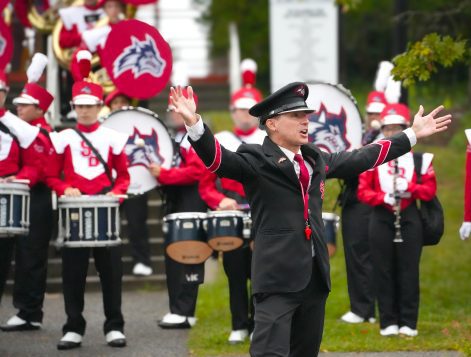By Katherine Kelton
To kick off Stony Brook Seawolves home football season, the university held the first of its Dean’s Challenge, when three deans of different colleges “guest coach” a game for three games, for a total of nine schools competing. Each dean competes to bring in the most people from their respective unit for a trophy, book scholarship and bragging rights.
The Stony Brook Development Team launched the first inaugural Stony Brook Athletics Dean’s Challenge for the fall 2023 semester. The mission is to build partnerships and bridge the gap between academics on campus and athletics.
Each school was given an opportunity to rally fans for football games during the fall season. The School of Social Welfare had the greatest attendance and was named the winner, receiving the Dean’s Challenge Trophy and a $250 book scholarship courtesy of the Athletic Department.
The first game this season included guest-coach David Wrobel, the new dean of the College of Arts and Sciences. He said, “We thought as a nice way to build community and get people out to the game, we would bring all kinds of food in addition to giving out tickets and college swag.”
CAS had the largest number of attendees and secured $500 for student programming.
Wrobel, who joined Stony Brook this fall after a previous tenure at the University of Oklahoma, explained his decision to come to Long Island. “The thing I love about this university is that it’s exactly what a public research university has to be,” he said. “It focuses on ensuring that kids from different backgrounds and financial circumstances have access to an incredible research-centric experience.”
Wrobel said of the football team, “I hope the football players do brilliantly, there’s a new coach [Billy Cosh] so that’s fantastic. The football players are also fantastic student-athletes.”
The other two deans who competed at Saturday’s game were Stacy Jaffee Gropack of the School of Health Professions and Peter Diplock of the School of Professional Development.
Aside from the healthy rivalries inside the university, other groups set up their tents, served food and played games. Their kids cartwheeled and threw footballs around. Stony Brook merchandise tents were scattered around as well.
Fans watched the football players in their tracksuits walk into the locker room. The marching band, cheerleaders and dance squad paraded around the perimeter of the tailgate area before performing in front of LaValle Stadium.
The light rain did not scare off tailgaters as many came prepared. Todd Rose, father of freshman player Ian Rose, said, “We’re from Connecticut. We were here for all the rainy games last year and it seems we are this year too.”
Todd Rose and his mother walked around handing out 3D printed badges and beaded necklaces that demonstrate team spirit. “We like to go to New Orleans and when you walk around they have all these beads and they have all the Major League sports teams and then they have your colleges,” he explained. “But, I never saw one for Stony Brook, so what I did was I took the picture and built it into my 3D printer, and designed it myself. I just give it to the parents of the players. So we know when a person is a parent of a player.”
Rose huddled under the tent with his wife, eldest son and mother alongside other football parents. James Amburn, father of Jacob Amburn, another freshman player, came from Berkshire County, Massachusetts, to watch the game. “I wasn’t too sure about Stony Brook at first,” he said. However, after they toured the school and the surrounding community SBU was a clear choice. “The atmosphere, the people are great, Port Jefferson is nice. Just a great experience,” he added.
The Seawolves beat Stonehill Skyhawks, 37-10, with an impressive two touchdowns in the first quarter. The next home game will be against Morgan State Bears Sept. 28 at 3:30 p.m.















































